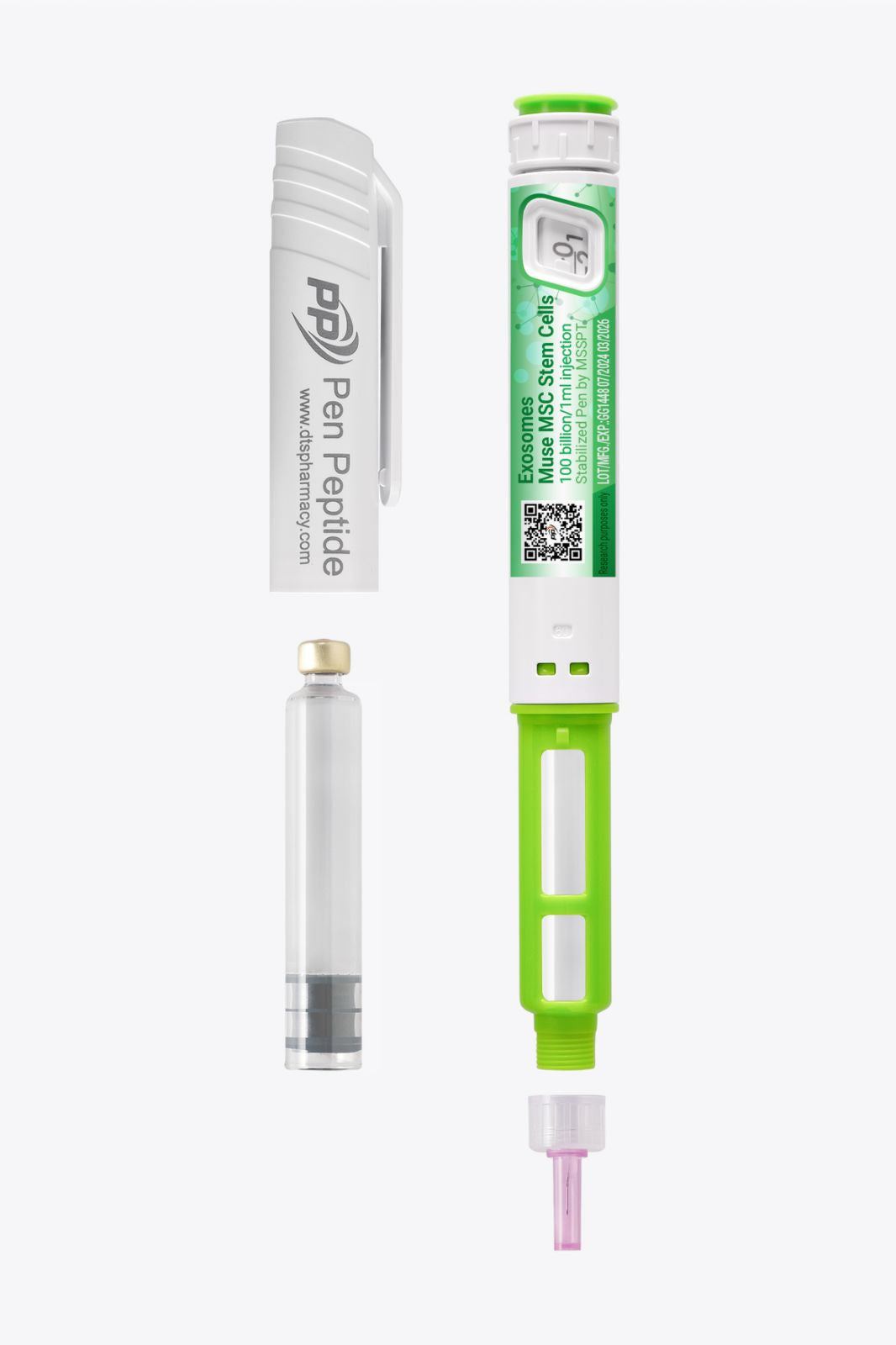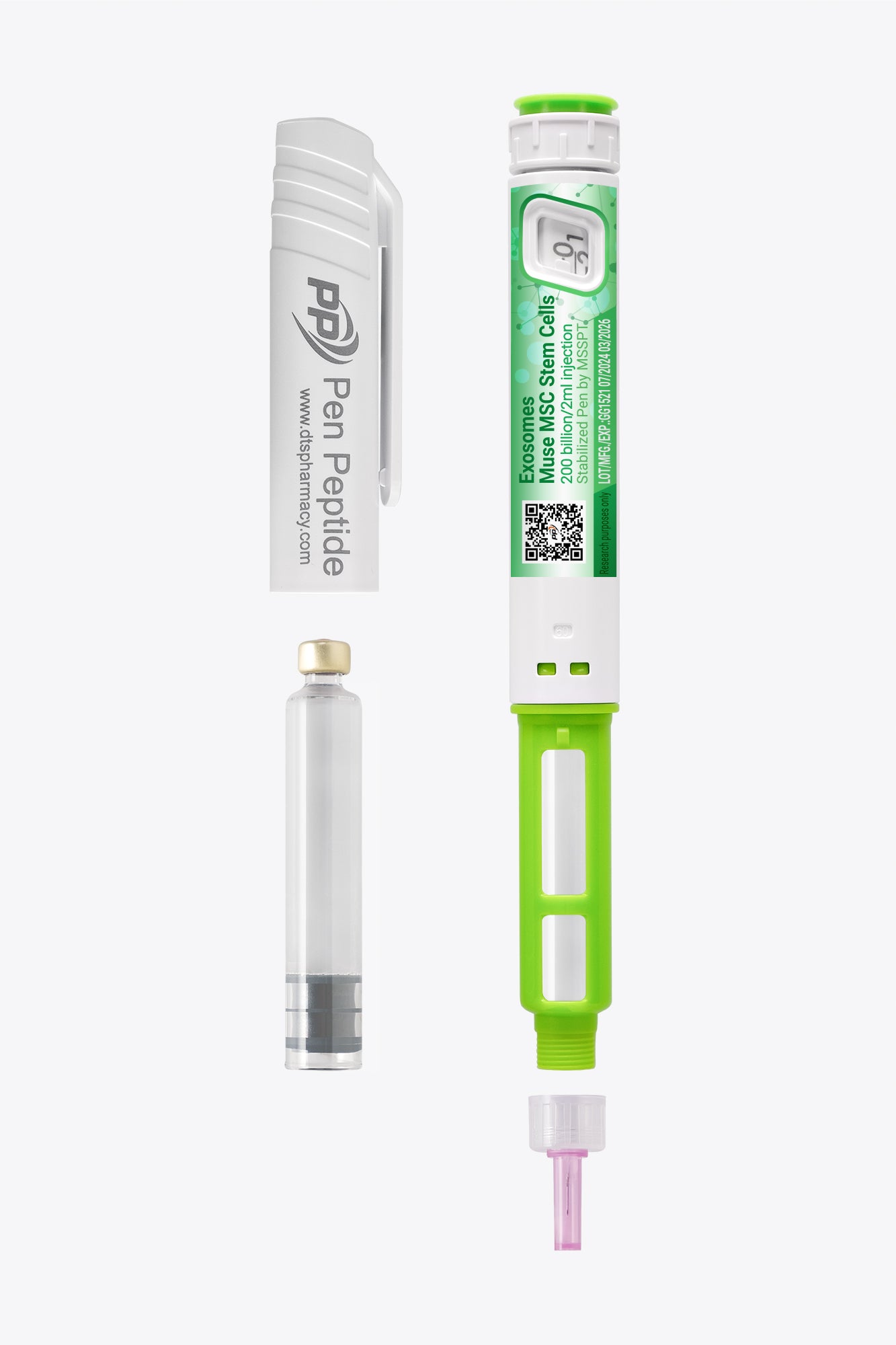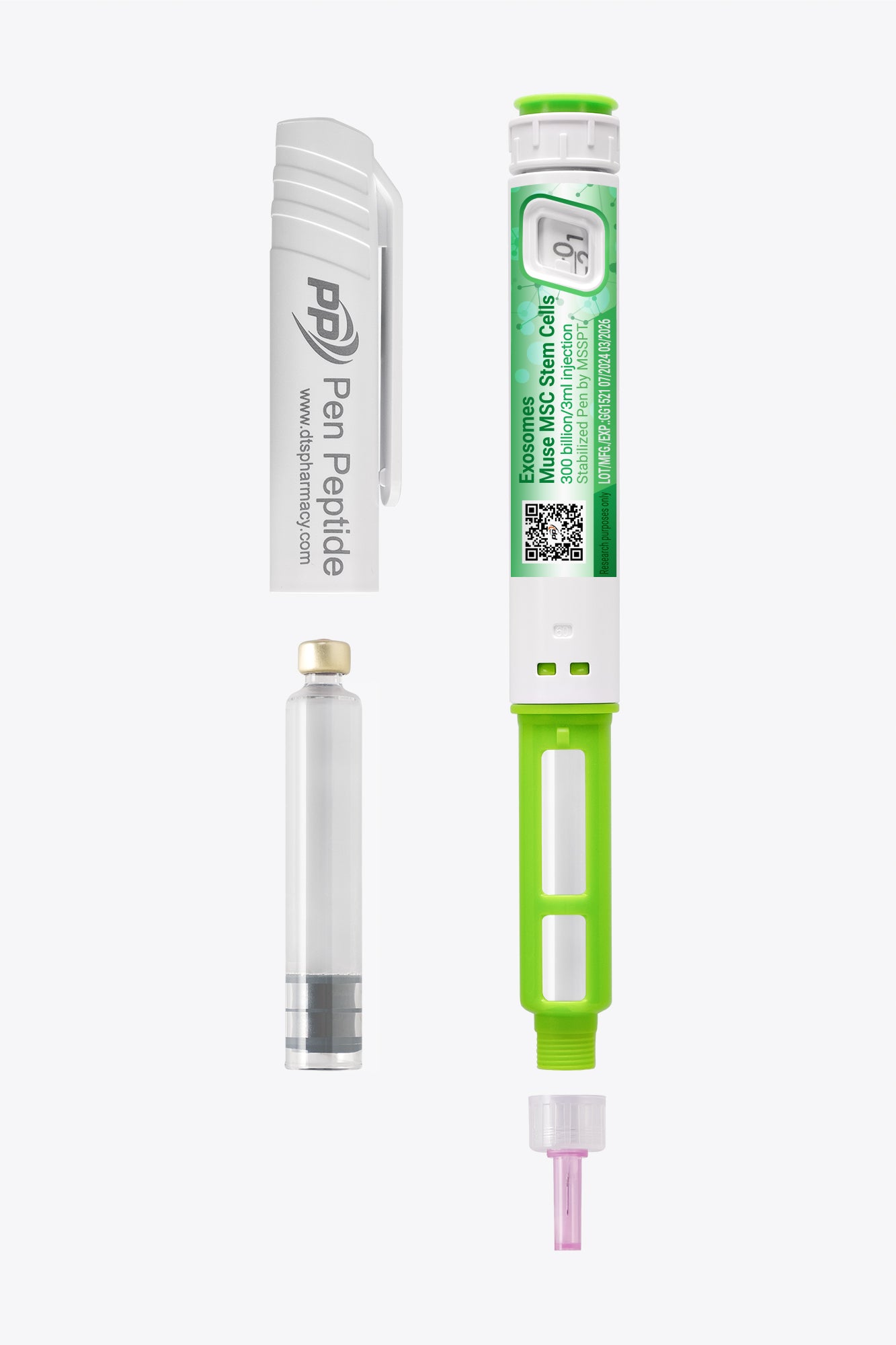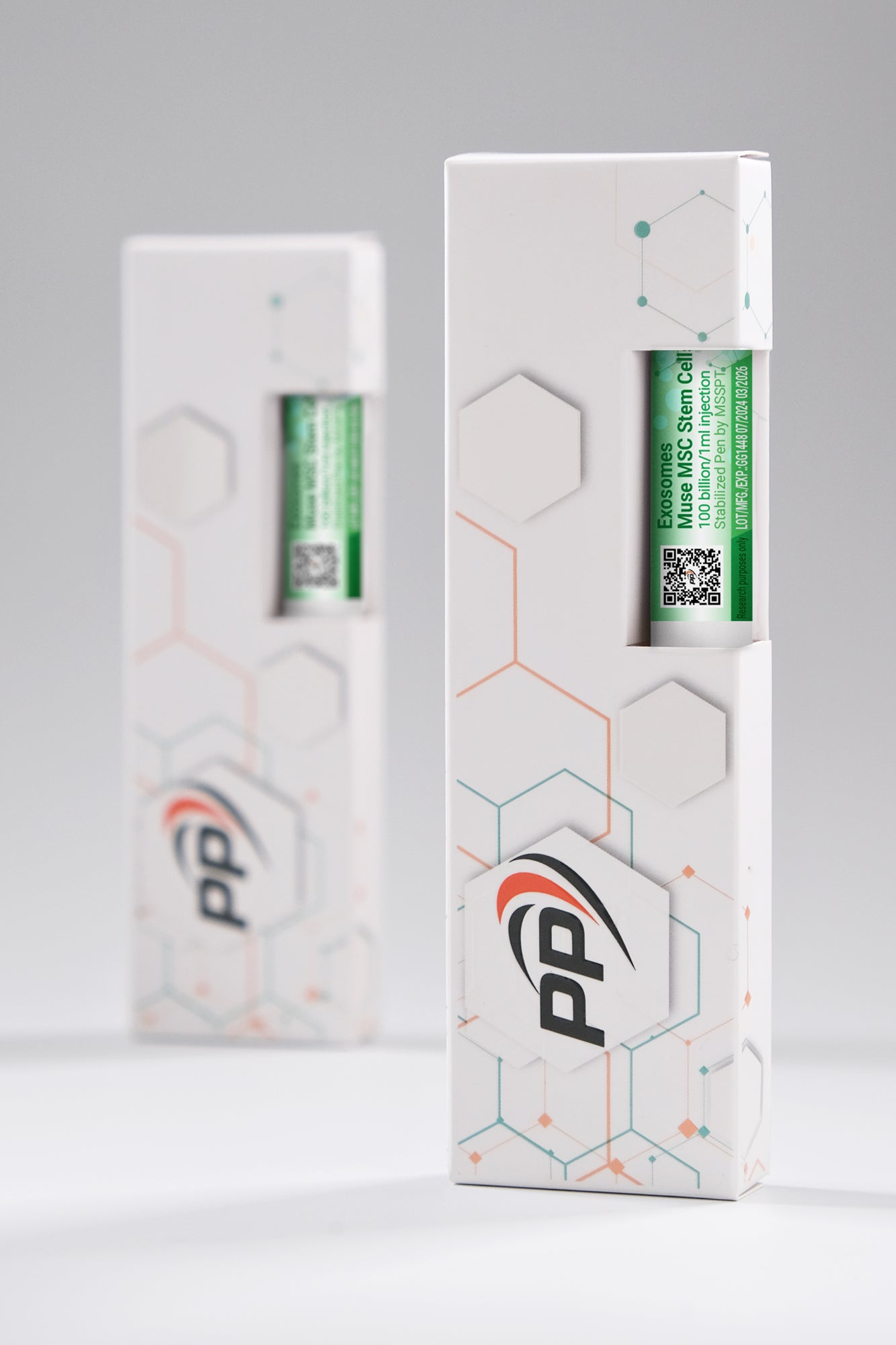Exosomes (Muse MSC Stem Cells) | Pre-Mixed Stabilized Pen
Exosomes (Muse MSC Stem Cells) | Pre-Mixed Stabilized Pen
✅ The first stabilized Exosomes in liquid form!
Couldn't load pickup availability
- 🥇 The first peptide brand with Pre-Mixed Pen stabilized formulations
- 📦 We ship with DHL Express in thermo-insulated packaging
- 💳 Secure payment by card or bank transfer
- 🧪 Purity ≥98% for precise research protocols
✅ Order and Delivery
✅ Order and Delivery
At Pen Peptide, we ensure fast and secure delivery of your order with DHL Express, maintaining the highest quality and reliability throughout the process.
How we process your order:
Once your payment is confirmed via bank transfer or debit/credit card, we dispatch your order on the next business day.
Orders are carefully packaged in temperature-controlled cooling boxes to ensure product integrity during transportation.
Delivery timeframe:
Standard delivery time within the Europe & UK: 1 to 3 business days (typically 1-2 business days for most locations).
Deliveries are handled exclusively by DHL Express, providing a fast and reliable shipping experience.
Tracking & order confirmation:
After your payment has been successfully processed, you will receive an email confirmation with your tracking number.
You can use the provided tracking link to monitor your shipment’s progress and estimated delivery time.
With Pen Peptide, you can trust that your order will arrive quickly and in perfect condition, ensuring a seamless and efficient experience.
✅ Why choose Pen Peptide?
✅ Why choose Pen Peptide?
If you are looking for peptides of the highest quality with over 98% purity, Pen Peptide is one of the best places where you can easily and securely order online. At Pen Peptide, we specialize in the synthesis of highly purified peptides intended exclusively for Research & Development Use Only.
Our peptides are produced in certified GMP laboratories, adhering to strict standards of quality, safety, and control. Each product undergoes rigorous testing for purity and stability to ensure you receive research materials with verified origin and maximum effectiveness.
We understand how important fast and reliable service is for our customers. That’s why we offer express delivery within 1 to 3 business days. All shipments are securely packaged to maintain product quality during transportation.
✅ Molecular Structure Stabilization Process Technology (MSSPT)
✅ Molecular Structure Stabilization Process Technology (MSSPT)
The Molecular Structure Stabilization Process Technology (MSSPT) focuses on preserving the structural integrity and functionality of molecules under harsh conditions and during prolonged storage periods. This process may involve modification of the molecule itself, optimization of storage conditions, or the use of auxiliary components that protect the molecules from degradation.
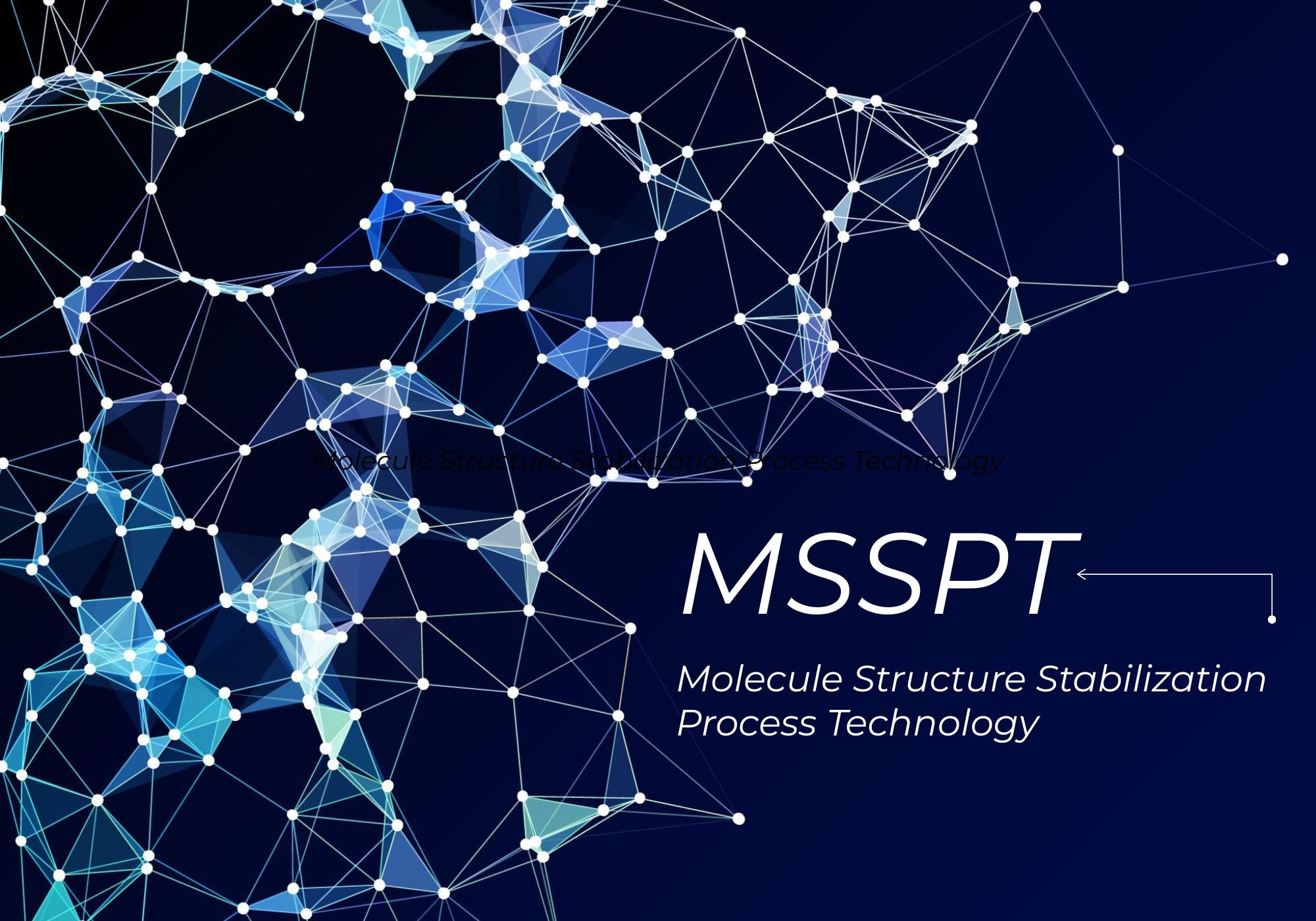
Key stages of the process:
1. Molecular modification:
Chemical and genetic engineering: Involves altering the structure or composition of the molecule to make it more resistant to degradation. For example, protein cross-linking can prevent unfolding, or modification can reduce susceptibility to chemical reactions.
Chemical modification: The introduction of protective groups or changes to reactive sites can prevent unwanted chemical reactions and degradation.
2. Optimization of storage conditions:
Lyophilization (freeze-drying): This method removes water from the sample, helping to preserve structure and prevent degradation during storage.
Storage in specialized containers: Using containers that protect from light and oxygen can safeguard molecules from photodegradation or oxidation.
Controlled-release systems: These systems provide a steady concentration of the therapeutic molecule, but introduce additional challenges related to stabilizing molecules over extended release periods.
3. Use of auxiliary components:
Buffers: Buffers help maintain stable pH levels, which are crucial for many chemical reactions and biological processes.
Antioxidants: These additives can prevent or reduce oxidative degradation, which is a common cause of molecular instability.
Stabilizing agents: These help prevent aggregation, precipitation, or other forms of degradation.
4. Understanding molecular interactions:
Thermodynamic equilibrium: A fundamental understanding of the interactions between a molecule and its environment is essential for developing effective stabilization strategies.
Detergents for membrane proteins: Specialized detergents, such as those developed to stabilize membrane proteins, help maintain their structure in solution.
Molecular simulations: Techniques such as molecular dynamics can provide valuable insights into the stability and behavior of molecules.
5. Examples of stabilization techniques:
Protein stabilization: Strategies include forming disulfide bonds, using stabilizing agents or chaperones, and introducing stabilizing mutations.
Polymer stabilization: Methods include the addition of antioxidants or the use of modified clay minerals that prevent polymer degradation.
Propellant stabilization: Stabilizers are essential to prevent the decomposition of propellants and ensure their safe and reliable performance.
Pen Peptide – Proven Molecular Stabilization
Our peptide pens are developed with a strong focus on preserving the biological activity and structural stability of the active compounds. Thanks to thoroughly researched stabilization processes—including optimization of storage environments and precise modification of molecular structure—we achieve long-term durability and reliability of the peptides under appropriate storage conditions.
The MSSPT (Molecule Structure Stabilization Process Technology) we use incorporates various approaches to maintain molecular integrity, including the use of suitable buffers, antioxidants, and stabilizing agents. The MSSPT technology allows for the integration of multiple active molecules into a compact volume without compromising their structural integrity or biological effectiveness. Additional optimization of storage conditions—such as pH control and prevention of photodegradation and oxidation—ensures maximum stability and bioactivity of the peptides.
These precise measures guarantee that the final product remains effective and stable even after extended storage periods, making it a secure and reliable option for use in various research protocols.
The exosomes from Muse MSC Stem Cells are offered in an innovative format – a pre-stabilized liquid pen, developed specifically for research protocols in the field of regenerative biology and cellular signaling. This form ensures a high concentration of bioactive components combined with high dosing accuracy, guaranteeing consistency and reliability in studies.
The stabilized liquid form allows direct use, eliminating the need for additional mixing or processing. This ensures optimal precision and facilitates application in research conditions.
What are exosomes?
Exosomes are nanoparticles derived from cell membranes that contain a rich array of signaling molecules – microRNA, mRNA, lipids, and proteins. They are a natural means of communication between cells and play a key role in maintaining physiological stability.
Scientific research shows that exosomes actively participate in processes related to repair, regeneration, and cellular adaptation to stress factors.
Biological role of exosomes
The main function of exosomes is to transmit molecular signals between different cells and tissues. They can activate regenerative mechanisms, support angiogenesis, and influence the immune system.
Their importance positions them as a key subject of research, covering both regenerative medicine and the processes of cellular aging.
Uniqueness of Muse MSC exosomes
Exosomes from MUSE MSC (Multilineage-differentiating Stress-Enduring Stem Cells) stand out for their resistance to cellular stress and their ability to maintain functional activity even under unfavorable conditions.
Their stable profile positions them as an advanced generation of biological carriers with potential in various areas of precision and personalized therapy. Compared to exosomes from other sources, Muse MSC demonstrate:
- Higher capacity for cellular regeneration.
- Improved resistance to oxidative stress.
- Greater stability in molecular composition.
- Enhanced efficiency in intercellular communication – providing more precise and targeted transfer of signaling molecules.
- Richer protein and RNA profile – containing diverse bioactive components essential for regenerative mechanisms.
- Strong anti-apoptotic potential – supporting cellular resilience and reducing cell death under stress.
- Broader spectrum of effects – influencing more cellular pathways related to repair and longevity.
- High biocompatibility – natural origin that minimizes the risk of adverse interactions.
Mechanism of action of exosomes
Exosomes act as mediator nanoparticles that transfer key signaling molecules between cells. Their interaction with the cell surface and intracellular mechanisms occurs in several main ways:
- Surface receptors – bind to membrane receptors and trigger cascades of signals that regulate processes such as proliferation, differentiation, and repair.
- Endocytosis – are internalized by cells and release their contents inside, modifying metabolic and genetic mechanisms.
- Membrane fusion – upon direct contact they transfer their lipids, proteins, and RNA molecules into the cytoplasm of the cell.
Through these pathways, exosomes deliver regulatory factors that can alter gene expression, improve the cellular response to stress, and support regeneration. This mechanism makes them a key tool for maintaining cellular plasticity and tissue repair.
Exosomes and cellular communication
As natural molecular mediators, exosomes maintain coordinated intercellular signaling – a process essential for tissue homeostasis and systemic balance. They play an active role in:
- Synchronizing cellular responses – coordinating the reactions of different cell populations.
- Maintaining tissue homeostasis – balancing tissue growth, repair, and degradation.
- Coordinating repair processes – supporting regeneration in response to damage and stress.
In scientific research, exosome-mediated cellular communication is considered a fundamental basis for future biomedical applications and novel therapeutic approaches.
Key benefits of exosomes according to research
Accumulated scientific data highlight that exosomes – and particularly those derived from Muse MSC (Multilineage-differentiating Stress-Enduring Stem Cells) – demonstrate a wide spectrum of biological effects, making them a valuable tool for studies related to cellular repair, regeneration, and longevity.
- Regeneration and repair – exosomes support the processes of repairing damaged tissues by transferring signaling molecules that stimulate cellular activity and renewal. This makes them a subject of research in regenerative biology, where mechanisms to activate the body’s natural repair capacities are being sought.
- Anti-aging potential – one of the most promising directions is their role in slowing cellular aging. By reducing oxidative stress and limiting damage to DNA and proteins, exosomes are studied as a factor capable of maintaining cells in a “functionally younger” state for a longer period of time.
- Support of cellular longevity – Muse MSC exosomes stand out for their potential to extend the functional lifespan of cells by enhancing their resilience to stressful and unfavorable conditions – a key aspect in longevity research and maintaining cellular health.
- Immunomodulation – exosomes play a crucial role in maintaining a balanced immune response. They can reduce excessive inflammatory activity while supporting the body’s defense mechanisms. This property is especially valuable in research focused on chronic inflammation and autoimmune reactions.
- Improved cellular resilience – thanks to their stable composition, Muse MSC exosomes help cells withstand oxidative stress and unfavorable conditions. This is a key factor in studies on aging and longevity.
- Cellular plasticity and adaptability – exosomes promote the ability of cells to change and adapt to new conditions, which is critical for tissue repair, regeneration, and maintaining a dynamic cellular environment.
Muse MSC exosomes are regarded as molecular mediators of rejuvenation and repair, combining regenerative and anti-aging potential. They open new perspectives for research in the field of cellular health, longevity, and the possibilities of slowing down the biological processes of aging.
Dosage and different formats of Exosomes (Muse MSC Stem Cells) | Pre-Mixed Stabilized Pen
The product is available in several formats:
100 BIL/1ml – sufficient for 5 days (total 100 units in pen)
200 BIL/2ml – sufficient for 10 days (total 200 units in pen)
300 BIL/3ml – sufficient for 15 days (total 300 units in pen)
Daily dosage in research protocol: 20 units once per day.
Biocompatibility and tolerance
Due to their natural origin, exosomes are characterized by high biocompatibility and low risk of immune reactivity. Data confirm a good tolerance profile in various research protocols. However, individual response may vary and should be considered in the context of the specific protocol.
Share
For laboratory purposes and personal observation only.
For laboratory purposes and personal observation only.
The information has been collected from numerous studies and analyses conducted over the years and is not intended for diagnosing, treating, or preventing any diseases.
